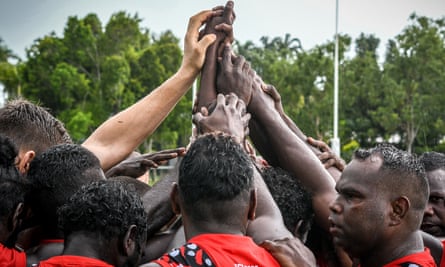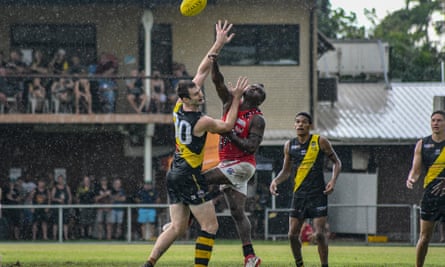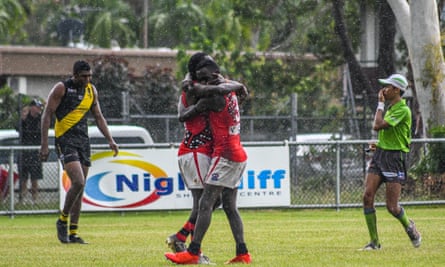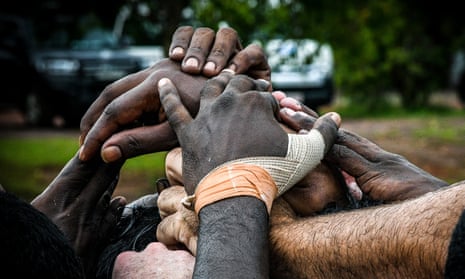“COMPANY – US MOB – WHY?”
The words are scrawled across the bottom of a whiteboard in the Tiwi Bombers’ changing rooms at Norbuilt Oval, 30km south of Darwin. The underdogs are preparing to play the second-placed Southern Crocs.
Overhead, rusty fans aren’t coping with the heavy January air. The benches creak, the showers leak. A small speaker pumps out upbeat saltwater R&B by a seven-piece outfit called B2M, which stands for Bathurst to Melville, the two main islands that make up the Tiwis.
While the rest of the country fixates on tennis and cricket, Territorians fixate on footy. The Northern Territory Football League (NTFL) runs through the wet season, from October to March, and the Bombers’ finals aspirations are in the balance. They have to win today, and again next week against top-placed Nightcliff, to be a realistic chance.
The Bombers’ coach, Brenton Toy, cuts the music and the players gather around. Short, bald and spirited, he picks out the words scattered across the board, most drawn from regular footy parlance. Attitude. Effort. Discipline. Spread. Structure. Then he taps his marker on the words that matter most – “US MOB”.

“No other club comes close to what we have,” he says. “The whole experience of this club – embrace it … we have a unique environment, and unique relationships.”
He randomly points at players. “My brother, my cuz, my nephew, my cuz, my brother, my nephew…” Football clubs frequently speak of themselves as families. Here, it’s no metaphor.
On today’s team-sheet, there are two Tipungwutis, three Puruntatameris, and two Munkaras. That’s just the brothers. The coach, Toy, the captain, Paddy Heenan, the veteran, Shane “Tippa” Tipuamantmirri, and the team’s newly recruited runner, four-time Hawthorn premiership player Cyril Rioli Jnr, are all related via their grandmothers.
The Tiwi Bombers were the first all-Indigenous team to play in a major competition when they debuted in the NTFL in 2006, and rarely play more than a trio of whitefellas. Most players live out on the islands, which float in the Arafura Sea 80km north of Darwin.
The island’s population is only around 2,500, which makes the Bombers tightknit and special. That sense of closeness is also what made the events that led to the club’s formation so painful.
In the islander’s language, Tiwi means one people. The word for Australian rules football is yiloga (pronounced yilowa). There is no word for suicide. The first death recorded as such on the islands was in 1989.
Then, between 1989 and 2008, 44 Tiwi Islanders died by suicide, an analysis by the Indigenous health researcher Leonore Hanssens of Charles Darwin University revealed. After reviewing all the coronial reports, Hanssens presented her findings to a Northern Territory Senate inquiry in 2009. She found that 24 of those suicides occurred between 2002 and 2006, many of them in small clusters that left the Tiwi Islands with one of the world’s worst rates of suicide per head of capita. The Sistagirls, a group of transgender Tiwi women, were particularly affected, but the majority of the deaths were of men aged between 18 and 40.
The death rate fell in 2007 and 2008, with one suicide in each of those years. That decline aligns with a broad community response to the emergency that began in 2006, which was documented by the Healing Foundation, an Indigenous health organisation that helps communities deal with trauma. Its report, Stories from Community, released late last year, drew insights from more than 80 community members. Music and sport, especially via B2M and the Bombers, were recognised by the foundation as important threads in the Tiwi narrative of recovery, because of their usefulness as tools for “engaging young people in stronger lifestyles and choices”.
Nationally, the Indigenous suicide rate has risen from 17.8 deaths per 100,000 people in 2008, to 25.5 deaths per 100,000 people in 2017. Earlier this month, a coronial inquest began probing the deaths of 13 Indigenous youths in the Kimberley region within a four-year period concluded. Five of those youths were children aged between 10 and 14, three were aged 16 or 17 and five were aged between 18 and 24. The Western Australian state coroner, Ros Fogliani, said the “profoundly tragic” deaths were “shaped by the crushing effects of intergenerational trauma and poverty upon entire communities”.

Senator Pat Dodson told Guardian Australia that Fogliani’s report “must lead a paradigm shift that leads to community-led solutions that address the clear sense of suffering, hopelessness and disillusionment that is being felt”. The release of the inquest findings closely followed a report from a Senate inquiry last December, which concluded that Indigenous suicide was at crisis levels, and that the history of dispossession, along with the social and economic conditions in which Indigenous people live, were key causes of suicide. In this context, and with emphasis being placed on the need for community determined and driven solutions, the Tiwi story – and the place of the Bombers within it – becomes instructive.
The Tiwi connection to the game began in 1941, when Brother John Pye introduced it to the islands. Later, he likened its significance to that of a “religion”. The small population produces eight teams for its local league, and two junior girls’ sides which compete in Darwin under the Bombers’ name. Several famous Tiwi have also dazzled crowds in the AFL.
An island-based team in the NTFL was a long-held ambition. Shane “Tippa” Tipuamantmirri hankered for it as a high school student in Darwin in the 90s. He’d spend his Fridays sketching out a team, using Tiwi players whose talents were scattered throughout the competition.
The dream became a part of the community’s suicide response. The footy legends Cyril Rioli Snr and Maurice Rioli Snr were among the instigators of the move.
On his bulging left-arm Tipuamantmirri has a tattoo of a dragonfly, a tribute to a friend. “She passed away through depression. And that was her art.”
The Tiwi traded with the Macassan people from Sulawesi long before Europeans arrived in Australia. The Bombers’ captain, Paddy Heenan, thinks it’s the Macassan vessels, not the Dutch or British ships, that inspired his totem – a sailing boat.
The Dutch landed on the islands briefly in 1636, but saw no one. In 1705, three Dutch ships encountered Tiwi men, shooting one dead. The British built an outpost near Pirlangimpi in 1824, but soon abandoned it. It wasn’t until 1911, when a Catholic mission was established, that Tiwi culture was threatened.
The researcher Leonore Hanssens outlines another clear chronology of events that reshaped life on the islands – the introduction of alcohol in the 1970s and ganja (cannabis) in the 1980s; a spike in family violence and suicidal behaviour; and then the first recorded suicide in 1989.
The Healing Foundation’s report also identifies grog and ganja, along with gambling, as primary reasons for “suicide ideation and attempts”.
In response to the emergency, the Tiwi Land Council banned full-strength beer at all social clubs. Patrons had a four-drinks daily limit, with no takeaways.
Mandatory alcohol-free days became commonplace. These measures, recognised in Hanssens’ research as crucial to the response’s effectiveness, remain in place. Their introduction coincided with a crackdown on black market grog and ganja.

But there were many other grassroots dimensions to the response. The Healing Foundation highlights the regular meetings convened within the traditional Tiwi skin groups – Takaringuwi (Mullet), Miyartuwi (Pandanus), Lorrula (Stone) and Warntarringuwi (Sun).
These gatherings allowed the community to develop long- and short-term approaches, and to discuss underlying issues, including intergenerational trauma. They provided opportunities for people to access mental health and suicide prevention workshops. There was also significant bolstering of the mental health workforce, which had burnt out by 2006.
These factors meant that the community was better equipped to deal with future suicides, and to prevent clustering. Hanssens’ work shows that clustering was a major part of the emergency on the islands, as it has been recently in the Kimberleys.
“The Tiwi people are a close-knit community in every sense of the word … the suicide clustering and contagion effect starts to become more overt in tightknit communities.”
Then, there was the formation of the Bombers, who “became a big part of the community”, the Healing Foundation observed. Sport and music provided “places and spaces for cultural knowledge to be shared, and where culture could work”.
Captain Paddy Heenan grew up understanding his cultural heritage and wants the same for his two-year-old son, Keith.

“I know my identity. I know where I belong, and where I’m from. I know my dance … Having my little one, I wanna be able to teach him everything I was taught as a young fella … Hopefully he’ll grow up being disciplined about things, and respectful.”
The Healing Foundation’s report confirms that suicide rates have fallen dramatically, largely crediting the organic community response. But the numbers over the past decade are not specified. The National Coronial Information Centre will not release location-specific data for the years 2008 to 2018 because the low number of cases means there’s a risk of victims being identified.
There is no room for complacency around what has been achieved. Tiwis are identified by research as being at high risk, and the Healing Foundation’s report says that people “know that the islands are not incubated or immune from future suicides”. In October, just before the season started, the Bombers lost a player to suicide.
Coach Brenton Toy was rocked. “The first reaction from everybody was shock. I think it reminded the group that nothing is guaranteed, and that we need to make the most of every moment.”
After the initial period of mourning was over, the conversations within the club changed to focus on avoiding recurrences. “The boys rallied together and chatted about what had happened, and made sure that everybody else had the appropriate support if they were feeling that way. And they had a chat about the impact it has on others, and dug deep around the broader impact that something like that has.”
The Bombers started the season with five losses, and Toy says the passing of their mate was one of several factors that led to that poor start. “I think subconsciously there was a weight we were carrying around that took us a while to offload.”

Toy was general manager, and an assistant coach, during the Bomber’s first full NTFL season in 2007/08. He observed the initial community reaction to suicide, and football’s place within it.
“I think there’s probably too much going on to say that footy is the one thing that made a difference … but it’s had a good impact on individual lives, and then generally in the community, I think it’s been a positive,” he says.
He talks about the different “themes” the Bombers discuss, which help the players to act as role models. “The majority of our boys have got kids, so we said, ‘Okay, what does it mean to be a good dad?’ I need to be there for my family, and look after them. That’s the same thing as looking after your teammates … being a good dad good also means being a good husband. We really tried to drill down into the individual and how our behaviours shape and affect others.
“I had guys that were sending me photos at night-time laying in bed with their kids reading a book. And it had nothing to do with footy.”
Toy’s observations about the role of football in the Tiwi response are similar to those of Dr Gary Robinson, another Indigenous health researcher at Charles Darwin University. He says that “football – whether it’s young women, whether it’s young men, or the Bombers – is part of it. It’s part of what provides opportunities and helps people deal with things … it’s good, but in terms of suicide and self-harm and all those things, it’s not a magic bullet.”
Dr Robinson says that there are lessons from the Tiwi response that can be applicable elsewhere, like in the Kimberleys, though the most at-risk there are teenagers, rather than adult males. As well as self-determination, community ownership, appropriate legislation, better health services and elements like sport and music are all parts of the model.
He adds a caveat – each community needs a tailored approach. “You’ve got to approach it by engaging and mobilising people in each place – families, elders, services and so on. That will depend on the specific set of circumstances.”
The Bombers run out 22-point winners over the Crocs, which means that when they gather again a week later to play the top-placed Nightcliff Tigers, their season is alive. Once again, Toy gives his players a final rev up. “We come in from OUR country, in OUR jumper,” he bellows.
The Bombers veteran Simon Munkara carries one of his children, and shepherds another three, as he leads his team out through a guard of honour. His mother, Alice, walks with them through a banner celebrating his 200th NTFL game.
He’s the first Tiwi to achieve the feat, which has meant over 32,000km of travel – enough to circumnavigate Australia twice. His brothers, Jack and Dion, are in the Bombers side, and his wife, Helena, and father, Danny, have travelled to the mainland to watch.

As the Bombers fight to play finals in intermittent rain, the brothers Munkara are entertaining combatants. One minute, Dion is kicking a goal and banging his heart in celebration. The next, he’s playfully pulling his opponent’s man bun. Simon kicks a trio of goals, nudging the Bombers in front in the third quarter.
The Tiwi love the ball kicked wide into the space on the wings, so they can use their speed and explode away from their opponents. Yiloga best translates as “your football” – not “the game as it should be played”, but the game played in your own unique way.
The Tiwi way is dazzling, and they look home early in the last term when they lead by 16 points. Then, they tire. With each Nightcliff goal, the roar of a tiger rings out via the crackly PA at the ground. Eventually, the home side holds a five-point lead with moments to go.
The game ends up in the hands of the Bombers’ talismanic forward, Ross Tungatalum, 20 metres out from goal. He can seal it himself, but instead handballs over the top of Nightcliff’s Jonathan Peris to teammate Michael Cooper in the goal square.
Cooper slips on the soft ground as the ball arrives, and drops it. Peris closes on him, then slips himself. An epic encounter finishes with a piece of comedy. The pair flap around in the goal square like dead fish. Peris throws a fist at the ball to try and rush it through, but instead, hits thin air.
The ball rolls into the path of Tungatalum, who shanks his soccer kick. It sneaks through for the goal that puts the Bombers well and truly back in the premiership race.
Soon, Toy will tell a packed changing room how proud he is of Simon Munkara, not just as footballer, but as a father.
But first, on the oval, the players, the Munkara family and the other Bombers supporters form a circle with Simon in the middle. As the circle claps in unison, his mother, Alice, dances slowly out from the crowd. When she reaches her eldest son, the rhythmic clapping turns into applause as mother and son embrace.
The Bombers won two of their last three games to finish third in the NTFL, thereby securing an unlikely double chance in the finals. They need to win next Saturday in a knockout preliminary final against the Southern Crocs to make the grand final at TIO Stadium on Saturday, 16 March.
Crisis support services can be reached 24 hours a day: Lifeline 13 11 14; Suicide Call Back Service 1300 659 467; Kids Helpline 1800 55 1800; MensLine Australia 1300 78 99 78; Beyond Blue 1300 22 4636
This story is co-published by The Citizen, a publication of the Centre for Advancing Journalism. Travel and research was supported by funding from the Melbourne Press Club’s Michael Gordon Fellowship program.
